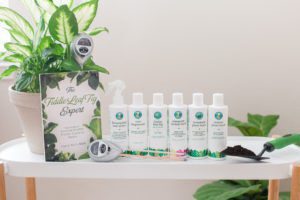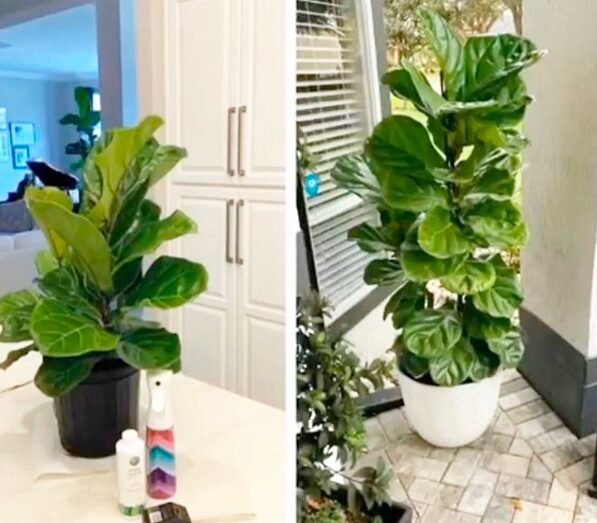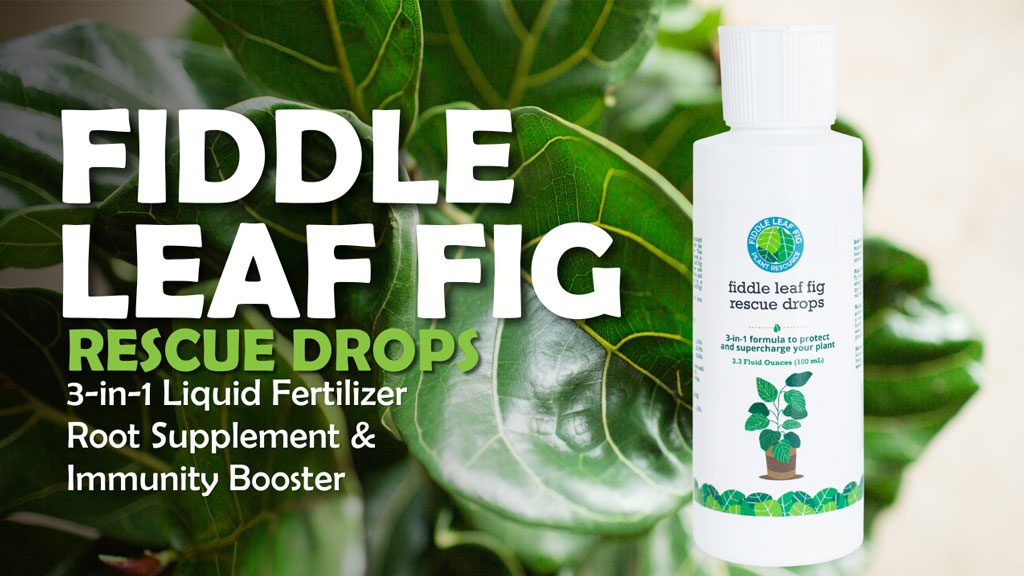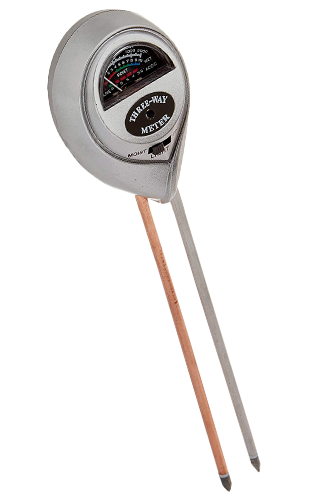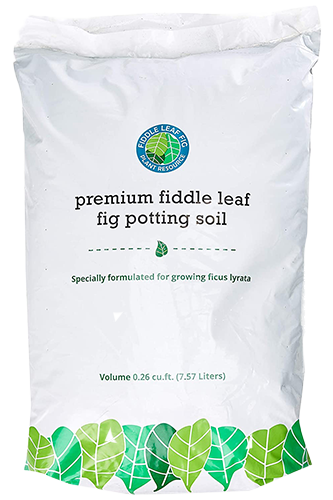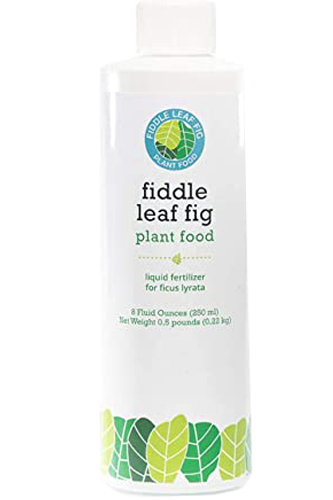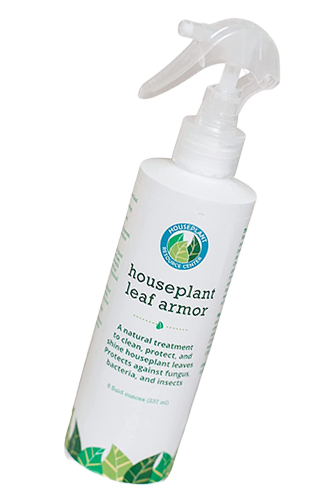Have you been looking for a comprehensive guide to fiddle leaf fig care all in one place? We thought so.
Take your plant propagation to the next level with our exclusive Notching Bundle, the essential tool for fostering healthier growth and lush foliage in your plants! https://amzn.to/463xe6W
Fiddle Leaf Fig Care Discussion Points
- The benefits of your plant
- Fiddle Leaf Fig Care 101
- The 10 commandments of fiddle leaf fig care
- The secret to proper watering and drainage
- Common problems and how to treat them
- The best fertilizer
- Propagation strategies
- How to learn more if you want to dig deeper on any of these individual topics
Welcome To The Fiddle Leaf Fig Plant Resource Center
Hi, I’m Claire Akin, and all of us at the Fiddle Leaf Fig Plant Resource Center are excited that you have invested in your relationship with your plant, and we hope this guide to fiddle leaf fig care will give you some really good tips and tricks to make that relationship more fulfilling.
First, welcome to the Fiddle Leaf Fig Plant Resource Center. You’ll find an abundance of information on our website, everything you’ve ever wanted to know about this plant. If you’d like to receive weekly email tips just for fiddle leaf figs, be sure to join our newsletter mailing list. We also have a Facebook group (over 20,000 members!), so if you’re having specific problems with your plant, this is the best place to go. You can post pictures, you can ask questions; there are tons of experts ready to offer recommendations to help you and your plant. We also have a YouTube channel that publishes every Fiddle Leaf Fig Friday, so be sure to subscribe so you can watch all of our latest videos. If you ask questions, we’ll create videos specifically to answer your questions! We also have a great fiddle leaf fig feed on Instagram, so don’t forget to check us out and follow us there. Visit our Fiddle Leaf Fig Plant Resource Store where you can shop all of our products. What more could you ask for?
My Passion for Fiddle Leaf Figs
Before we dive into fiddle leaf fig care, I’d like to give you a little background information on my story and my passion. I grew up growing roses with my mom and my grandmother. My grandmother had all kinds of beautiful houseplants; she actually had a fiddle leaf fig back in the ’70s before they were popular. So, I think that’s really where I got my houseplant passion. And my mom is an amazing rose grower; she has this incredible rose garden. So that’s where I got my outdoor gardening passion. You could say I’m really just a houseplant lover—a plant lover in general.
As I progressed on my plant journey, I really got into fertilizers, which I consider to be my specialty. I learned everything that I possibly could about plant fertilizers, both for indoor and outdoor plants. I am now a lecturer at UCLA extension, so it’s my mission to really empower you (and everyone!) to care for your fiddle leaf fig with confidence. When I first started with these plants, I got a little bit overwhelmed because when I went online I couldn’t find any easy-to-follow advice. It was kind of overcomplicated, and I couldn’t find a straight answer to common questions.
My Fiddle Leaf Fig Care Mission
My goal has always been to cut through the noise and give people an easy, fun, and actionable way to improve the health of their plant. In this article, my mission is to share everything I know about fiddle leaf figs, troubleshoot the most common issues people have, and to share easy propagation methods (because it took me years to get started propagating my fiddle leaf fig!). Propagation is actually really easy and really rewarding!
I want to help you enjoy your plants longer and just have fun in general. After all, why do we have houseplants if they’re not going to bring joy into our lives?
Why I Created The Fiddle Leaf Fig Plant Resource Center
I created the Fiddle Leaf Fig Plant Resource Center because I believe in the power of houseplants: houseplants really do something special for us. We know that they’re good for our environment. We know that they’re good for our health. But I think they’re also good for our confidence, the way that we think about ourselves, and the way that we nurture each other. It’s just such an amazing relationship to grow a plant and to keep it healthy, listen to it, watch it, and use your intuition. I believe that the more you grow houseplants, the more confident you become, not only in growing houseplants, but also in other areas of your life.
I hope to simplify confusing information and help out new growers. We know that for 90% of people who get a fiddle leaf fig, that’s their first houseplant—and it’s not necessarily the easiest plant to start with—so they often face a lot of problems. It’s my fear that people buy a fiddle leaf fig, they face problems, and they give up on houseplants forever. I don’t want that to happen. So I want to make things as easy as possible, especially if you’re a new grower, so you hopefully have a really good outcome and then a lifelong relationship with plants that brings you a lot of joy.
Before we get started, I want to mention our products, which we created specifically for fiddle leaf figs, and into which we really have put a lot of love and care. We have all kinds of specialty houseplant products: a fertilizer, a moisture meter, a root rot treatment to treat the common problem of root rot (which is brown spots or dropping leaves), a leaf armor spray, just to name a few. I even wrote a book, The Fiddle Leaf Fig Expert. So if you’re in need of supplies for your plant, look no further than the Fiddle Leaf Fig Plant Resource Center.
Houseplants Are Mysterious & Wonderful
Let’s start off by talking just about houseplants in general. They are mysterious and wonderful, and, like I said previously, they do something special that isn’t necessarily intuitive. More than making our spaces beautiful and purifying the air, they also have a strange and mysterious connection with us. One of the ways I like to show this is through an IKEA plant video. There are a lot of experiments along these same lines, but IKEA actually put two plants that are exactly the same, and with exactly the same growing conditions, right next to each other. Then one plant was bullied; so people said terrible, mean things to it, it didn’t get any love, and it didn’t get any appreciation. And then the other plant was complimented; so people said nice things to it and were positive toward it. The results were astounding. (To see the video and read more about it, click here.)
No one really knows how this works, but it’s been demonstrated over and over with different studies and different experiments. Houseplants have the power to feel the feelings and the intentions that we put toward them. I think it’s just so incredible that if we take care of our plants, they take care of us, and it’s this mystical relationship. Therefore, I ask that you open your mind and just consider that maybe there’s something going on; we’re not necessarily fully aware of how it works, but it definitely works. And it’s just a really incredible gift!
Are Fiddle Leaf Figs Hard To Grow?
So let’s answer your first question. Are fiddle leaf figs hard to grow? People will tell you, yes, they are hard to grow. I think this response is simply people believing that because fiddle leaf figs are so beautiful and stunning that they couldn’t possibly be easy to grow—but they are easy to grow! The picture below is of a giant fiddle leaf fig that’s growing free and happy in the wild—no fertilizer, no water, it’s just growing. And it’s huge—over 30 feet tall!

You’ll find a lot of conflicting advice online; some people try to tell you that it’s hard to grow fiddle leaf figs, and houseplant gurus sometimes try to overcomplicate the subject for some reason. But even in San Diego, fiddle leaf figs grow 60 feet tall in the wild. At Disneyland I’ve seen several giant fiddle leaf figs; and that’s in Anaheim, which is not a really nice environment for houseplants, as it’s dry and arid. So fiddle leaf figs can grow to be huge and healthy in a variety of conditions. The main thing I want you to know is that growing a healthy fiddle leaf fig is not that hard. If you give them the right conditions, they will do really well.
Let’s discuss the challenges that we face growing houseplants in general. I like for people to understand a foundational knowledge about houseplants; while plants grow easily and naturally in the wild, it won’t be the same indoors, which presents quite a few constraints for plants.
First, drainage is a problem. In the wild, plants grow in the ground, where they have unlimited constant drainage that’s perfect at any moment in time. This means that their roots are never sitting in water, they’re never too wet, and they’re hopefully not too dry. And especially where fiddle leaf figs grow in nature (in a rain forest where it rains daily), they get misted and bathed every day. It’s the perfect drainage environment.
Inside our house, it’s not that easy, right? Inside our plants are watered maybe once a week, sit in relatively wet conditions for a little bit of time, and then they dry out; so they have to be a bit more resilient. And the temperatures are a little bit different. Fiddle leaf figs like to be warm, and they like a lot of humidity. They also have a lot lower relative humidity. It’s not raining every day in our house, and certainly, there’s a lot less light in most of our homes than in the rain forest. The biggest challenge for fiddle leaf figs is drainage and sunlight. If you can address these two challenges, your plant will do really well.
Plants in general, not to mention outdoors, constantly have decaying matter fall, with insects breaking down the matter, so they’re constantly being gently fertilized with organic matter. To give your plants a gentle fertilization that is something similar to what they would get in the wild, we must address these factors in our indoor conditions.
The Benefits Of Your Fiddle Leaf Figs
Obviously, these plants look stunning in your home, and every commercial or designer home that you see on TV has a fiddle in it. More than being gorgeous, they also purify the air; in fact, they may purify the air better than any other houseplant. They do an incredible job of removing toxins from the air and releasing pure oxygen.
Fiddle leaf figs increase the relative humidity of your home, which is good for people with asthma or allergies, or even if you have a sore throat, humidity and purified air the things that are going to help you feel better. They reduce illnesses, they improve your mood, they boost productivity at work or in your home office. I believe they bring good luck, and they create less stress and greater happiness in your life. Putting a fiddle leaf fig in your home, especially in an area where you spend a lot of time, is really a way to improve your quality of life.
Great Books About Houseplants
I love to read, and I hope you do too. I’d love to recommend some of my favorite books about houseplants. First of all, I recommend The Fiddle Leaf Fig Expert because it includes everything you’ve ever wanted to know about these plants.
Another great book is How to Grow Fresh Air, written by NASA scientist Dr. B. C. Wolverton, who was tasked with choosing the best houseplants to purify air on the space station. It goes through everything you need to know about how houseplants purify air, the toxins that they take out of the air, and how to improve your air purification. I highly recommend this interesting book!
Coming soon we also have Houseplants for Millennials, which is filled with cool tips and tricks for adding houseplants to your home using feng shui for plants, designing with houseplants, and then choosing the best plants for individual rooms within your homes.
Brief History Of Fiddle Leaf Figs
Let’s discuss a brief history of the fiddle leaf fig. They’re native to the rain forests in West Africa and Australia and a member of the mulberry family, which has over 900 plant species in it. In the wild, fiddle leaf figs grow a green fig-like fruit and have flowers. Although now a docile houseplant, in the wild, the fiddle leaf fig can behave quite differently; they are actually a killer in the wild. Ficus lyrata are types of banyan figs, which means they start life as an epiphyte. Epiphytes grow by landing as a seed at the very top of another tree, where there is abundant sunlight. When the seed germinates, it grows downward towards the ground and may strangle its host plant as it competes for sunlight in the thick rain forest. Luckily this isn’t going to happen in your home. However, fiddle leaf figs are extremely aggressive toward growth and very adaptable to live in different conditions. I guess you could say they have a very strong will to live.
The Rise To Stardom
Fiddle leaf figs have experienced a dramatic rise to stardom. It’s so interesting to me when I watch shows or movies from before the 2000s—there was not one fiddle leaf fig! But now every Super Bowl commercial, every movie, and every show has figs everywhere. The rise to stardom really coincided with Pinterest, which was launched around 2010, and all of a sudden, fiddle leaf figs went crazy. All the photography on Pinterest and in the home design blogs featuring fiddle leaf figs made everyone want one.
After they broke out around that time, they’ve been the number-one selling houseplant ever since.
Fiddle Leaf Fig Care 101
If you’re a novice grower, I’d like to lay the foundation of fiddle leaf fig care for you.
So how do plants work?
Let’s go right back to high school, back to photosynthesis. Plants need sunlight; they take energy from the sun, carbon dioxide, and they use chlorophyll to synthesize this. They release pure oxygen as well as sugars, which they use for their own metabolism and growth. So through their roots, they take in water and nutrients to run this whole metabolism. In general, plants need energy, carbon dioxide, water, and then they release pure oxygen. Since we take in oxygen and expel carbon dioxide, they’re the perfect complement to humans. So it’s kind of a great symbiotic relationship in our home—not to mention they look beautiful.
The anatomy of your plant
There’s the root system, the stomach or trunk, and then the leaves, and they all work together to run the plant’s metabolism. Plants in the wild typically have flowers and fruit; both are needed to reproduce and germinate in the wild.
It’s important to know that even though you can’t see them, your plant’s roots are critically important to its health. Diseases often start in the roots, whether the roots are sitting in water or they get an infection or they’re compacted, which results in a spiral of sickness and health. Then the story is told by the plant’s leaves; you’ll see dropping leaves, yellowing leaves, or brown spots on your leaves. So when thinking about your plant’s health, pay attention to the whole plant.
What do plants need to thrive?
First of all, they need lots of light—the more, the better. Although they can get sunburned if they’re in direct sun (which we’ll discuss a bit more later), generally, plants inside your home need as much light as possible.
Plants also need carbon dioxide, which is no problem in our atmosphere. Of course, they need water—not too much, just the right amount—so they need a really fast-draining soil. Most people know plants need water, but they don’t realize that because plant roots actually take in air themselves, they need access to both moisture and air through the plant roots. So that’s why we recommend our fast-draining and well-aerated soil, Premium Fiddle Leaf Fig Potting Soil, to provide your plant with the perfect soil and the right mix of nutrients. Remember, fiddle leaf figs need a specific NPK ratio because they are relatively fast growing and have relatively large leaves; our Fiddle Leaf Fig Plant Food is the perfect balance ratio for their growth.
Another thing plants need is loving attention. I’m not joking, they really do need love and attention. The more you pay attention to your fiddle leaf fig, the better it’ll do. I’ve seen this happen in my own home time and time again; when I get plants and I ignore them, or I don’t really care for them as much as my other plants, they don’t do as well. My favorite plant is a very good monstera; I look at it every day, and we just have this great relationship. And it is the plant that’s growing the fastest and that’s doing the best in my home. I promise, you’ll notice that the more love and attention you give to your plants, the better they will do.
The 10 Commandments Of Fiddle Leaf Fig Care
There’s really only 10 things you need to know to become a master of growing fiddle leaf figs.
1. Excellent drainage
I can’t say it enough, they really do need good drainage. I often see first-time plant owners take these beautiful plants and put them in a container that has no holes. And people will tell you that this is okay. I don’t know why anyone would tell a novice grower, “Yeah, they don’t need drainage, just watch how much you water.” This is not true. I’ve never seen anyone successfully grow a fiddle leaf fig in a container with no drainage.
The best way to do drainage is to have an interior pot that has really good drainage and an exterior decorative pot, whether it’s a basket or a beautiful gold pot or whatever you choose. When I started out with houseplants, somebody had to tell me this too, so don’t be embarrassed if this is news to you.
2. Fast-draining soil
Inside a pretty exterior container, the interior pot provides the functionality of your drainage, but a fast-draining soil is so important. I really had a lot of problems with my first fiddle leaf fig when I was using Miracle-Gro indoor potting soil. Bless them at Miracle-Gro; they’re trying to do the hard job of creating one potting soil that works for all houseplants. This is next to impossible: ferns like to be moist all the time, and there’s a lot of plants that like to dry out between watering. So coming up with one soil for every houseplant is impossible, and Miracle-Gro’s soil just holds way too much water for a fiddle leaf fig. We believe our fast-draining Premium Fiddle Leaf Fig Potting Soil works best.
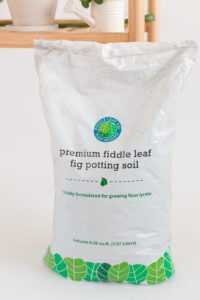
Our potting soil works really well not just for fiddle leaf figs, but also for arrowheads and monsteras—actually, for most houseplants, except for ones that like to stay really wet such as khalifa or ferns. If you don’t want to buy a specialty soil, take a normal soil like Miracle-Gro indoor potting mix, mix it with half bark or half cactus mix, and that will really lighten it up to aerate and drain faster.
3. Don’t overwater.
Overwatering is the number-one reason I get emails every day from people killing their plants. I myself am an overwaterer. I love my plants so much that I give them too much attention and too much love and I pour too much water on them. This is where a soil meter really comes in handy, and we make one specifically for fiddle leaf figs. It’s important to stick the meter in the soil to tell how wet it is down at the root ball. You may think that the top of the soil is dry, but it could still be completely wet down at the bottom. Be sure to test before you water.
I recommend watering once a week or less. Some of my fiddle leaf figs I water once a month, some every two weeks, and some every week. It depends on the size of the container, how big the plant is, and how well the soil drains. Once you get to know your plant, your container, your drainage, your soil, where you live, and how hot it is, you’ll really start to get a good feeling for how fast your plant is going through its water.
A moisture meter really helps give you a quantifiable number (1 to 10) where you can say, “Okay, it’s a 6, I’m not going to water until it gets to a 4,” and then when it’s a 4 or less of moisture, you go ahead and water. This has really helped build my confidence and my ability to judge how wet the soil looked at the surface by actually getting data from down below the surface.

4. Give maximum indirect light.
If you live in the Northern Hemisphere, put your fiddle leaf fig in a south-facing large window if you can, so it can get most of the sunlight during the day. In an east- or west-facing window is not as beneficial because it just gets half a day of sunlight; and in the morning, the sun isn’t that strong, whereas in the afternoon, it may actually be too strong. So if you live in the Northern Hemisphere, putting your plant in a south-facing large window is your best bet.
However, here in San Diego, I have fiddle leaf figs in a north-facing window—but it’s a huge sliding glass door with a lot of light. It really depends on your home and what’s happening outside your windows: Do you have an overhang? Do you have a pergola? Or do you have a lot of trees? Generally, you just want to put them in the sunniest place you can find.
What’s interesting about light and fiddle leaf figs is that when you first get your plant, they are used to about 50% of full sun. In the greenhouse conditions where they’re grown, they’re getting about 50% sunlight, to which they adapt pretty well. It takes them about a month to adapt to different lighting conditions, so when you bring your plant home from the nursery, put it in the sunniest location in your house for a month. After that month, move it to a darker location, and it will adapt. That’s one trick to getting your fiddle leaf fig to where you want it to eventually be without shocking it with too much change.
5. Treat problems immediately.
Fiddle leaf figs can go downhill in a hurry if they get root rot. They can drop all of their leaves within a week or two, which is really scary and sad to see. So with root rot, you really want to jump on it and treat it immediately. We make a root supplement that will stop root rot in its tracks; it works on both bacterial and fungal root rot. Generally, you’ll want to repot your fiddle leaf fig into a fast-draining soil, treat it with a root rot treatment every two weeks until everything looks good and the condition stops, and then treat it once a month going forward to protect it in the future.
6. Repot when needed.
There are a few reasons why you’d repot your fiddle leaf fig. The first is if you’re having any problems with it. If it feels like it’s not draining fast enough, if you have brown spots, if you have dropping leaves, then you’re going to want to repot it into a better soil. The second is if it’s not growing as much as you’d like and it’s root bound. So if it’s outgrown its container and it doesn’t have enough space, then repot it into a larger container. If you don’t want it to grow larger, just don’t repot it.
Instead of repotting, you could actually top dress the soil. What I mean by this is to just replace the top 3 to 4 inches of soil with new soil, which will give it nutrients, a little bit better protection, but it won’t allow it to grow much larger (if, say, you’re constrained by the space that you have and you don’t want new growth).
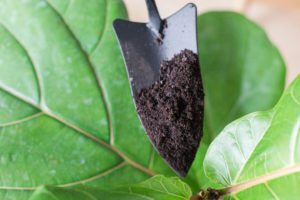
7. Feed them properly.
Our Fiddle Leaf Fig Plant Food is designed specifically with a NPK ratio for fiddle leaf figs, and it’s also designed to be super gentle. Because this plant food is a liquid, it’s readily absorbed by the plant’s roots, and it’s designed to be used every single time you water. This is important for two reasons.
First, your plant is getting more of a gentle dose of vitamins every time (just like you take a daily vitamin, not a monthly vitamin, right?), which it can easily absorb. This way, by not accidentally adding too much solid or slow-release fertilizer, you don’t run the risk of burning the root system and causing a lot of problems for your plant.

Our Fiddle Leaf Fig Plant Food is designed to be used every time you water, which means you don’t have to worry about forgetting or marking your calendar to fertilize; you just use it. Put a teaspoon into your watering can every time you water so you’ll get sustained steady health and growth out of your plant. Check out our reviews if you have any questions. We’re really proud of this product. Buy it on Amazon here!
8. Rotate your plants for even growth.
I often get emails from people with these lopsided plants that are leaning, almost falling over. So let me make it clear here: It’s important to rotate your plants!
Whenever you water your plant (maybe it’s once a week, maybe it’s every two weeks), you want to inspect it and you also want to turn it maybe a quarter of a turn, so that it gets even growth all the way around. Just like with your Christmas tree, you don’t want one side to look good and the other side to be bare; you want it to be even. So I recommend rotating your plant one quarter turn every time you water.
9. Clean your plant’s leaves.
You would be surprised how important this is for the health of your plant. I was actually just looking at one of my oldest plants today and I realized that its leaves were dusty—and that’s why it’s not doing so well right now. This weekend I plan to wash them off and do a little leaf shine. There are a few reasons you have to clean your plant’s leaves. Primarily, your plant takes in carbon dioxide through the stomata or the pores in the leaves, so we want those to be clear. Secondly, your plant absorbs light through the leaves, and so dust really depletes the amount of light that it can absorb. So rinse it off in the shower, or with the hose if you can take it outside; or you can wipe it down with water and a cloth.
You don’t need to use any cleaners or soaps on it; water really is the best thing. We also make a Houseplant Leaf Shine and Armor that helps to dissolve some of the dirt on the surface and allows your plant to retain more of its natural moisture. This product is completely natural; aloe and sea kelp are the main ingredients, which give your plant that beautiful glossy finish. It also repels insects, fungus, and bacteria, and then locks in that moisture—much like using lotion for your skin.
Other than this light spray to give your plant a little bit of shine and protection, I’m not really that big on leaf shine sprays; I just like a clean plant. So I recommend just cleaning it on a regular basis with clean room-temperature water.
10. Check on your plant every week.
Fiddle Leaf Fig Friday is one of my favorite tips! I recommend that every Friday you check on your fiddle leaf fig, inspect it, make sure there’s no bugs, no holes, no spider mite webs; make sure that it’s clean and maybe stick in a soil meter to see if it’s wet or dry. Just see how it’s doing. If there are any brown spots, think about treating it for root rot and removing those damaged leaves.
Make it a point once a week to send your plant some love and just enjoy it. The key really is consistency and thoughtfulness in fiddle leaf fig care by checking on your plant and bonding with it each and every week.
These 10 commandments of fiddle leaf fig care are really all you need to know to become an expert fiddle leaf fig grower. It’s that simple!
The Biggest Threat To Your Plant: Overwatering
If you only learn one thing about fiddle leaf fig care from this article, please don’t overwater your fiddle leaf fig. A lot of people don’t know if they’re underwatering or overwatering their plant—it can be confusing!—but your plant will really do a lot better if you err on the side of too little water. If your plant’s root ball is really compacted or there’s soil compaction, you could actually be pouring a lot of water on your plant without any of it getting into the root ball.
That’s why it’s important to be able to distinguish the difference between overwatering and underwatering.
The plant below was left in a hot apartment for about three weeks while its owner went on vacation, and it completely dried up. You can see the leaves are shriveled, they’re crispy, they’re dry; this is one dry plant, and it probably will not recover.

And then this next plant (below) is overwatered, and you can see the brown spots at the base of this leaf that dropped, which is the first sign of root rot. The key sign to know if you’re overwatering your plant, root rot will appear in the form of brown and black spots and dropping leaves.

Are You Overwatering Your Fiddle Leaf Fig?
To tell if you’re overwatering, ask yourself the following questions:
Do you water more than once a week? If so, I’d say your plant is probably overwatered.
Is this soil wet to the touch about one inch below the surface? Stick your finger or a chopstick in and find out.
Do your plant’s leaves have dark spots or dark edges? This could definitely signify too much water.
Are there flies, gnats, or a musty smell in your plant’s soil? This probably means that your plant is way too wet.
Are You Underwatering Your Fiddle Leaf Fig?
To tell if you’re overwatering, ask yourself the following questions:
Are the newest leaves smaller than the existing leaves? This sometimes indicates that your plant has gone through a drought during a growth spurt (I’ve done this to my plants accidentally), which can result in the new leaves being small, shriveled, dry, or crispy. This can be caused by thirst, heat, or just dryness in your home, but it is key that your plant not get too dry during a growth spurt.
Does your plant have yellow leaves? This can be a sign of underwatering; it also can be a sign of not enough fertilizer.
Is the top inch of soil very dry? Your plant is probably thirsty.
Has the soil pulled away from the pot? This means that your plant has gotten really, really dry in the past and the whole soil system has shrunk. In this case, give your plant a drink!
Could It Be Erratic Watering?
A lot of times people get confused about how to water their plant and end up watering erratically: overwatering it and then letting it completely dry out over the period of a couple of weeks so that the soil recedes from the container. Then when they go to water again, the water just goes around the outside of the soil. The plant’s root ball is still dying of thirst but because they’re watering it, they don’t understand what’s happening.
The remedy in this situation would be to loosen up the whole root ball and repot the plant; then give it a really good soak and just start over fresh. And, of course, make sure it doesn’t completely dry out in the future.
How To Water Your Plant The Right Way
For optimal fiddle leaf fig care, first of all, aim to water weekly or every two weeks. You can always add more, so erring on the side of less, use the soil or moisture meter until you’re confident. And make sure that you have proper drainage and a fast-draining soil.
There are many different watering strategies, so I recommend using the strategy that works for you. There are two main ways that I water fiddle leaf figs.
The first method is the cup method.
For a small fiddle leaf fig, water your plant with 1 cup of water every week or so. This is a great method for beginners because you do not run the risk of overwatering your plant, and it’s easy to be consistent. If your plant is over 2 feet tall, you would water with 2 cups of water. If it’s over 4 feet tall, you would do 3 cups of water. Then just do this every week and watch your plant. This is a great baseline strategy to start with.
The second strategy I use is watering until 10 to 15% of the water drains from your pot.
This means fully watering the root ball and the soil until the water drains from your pot; then you’ll know that you’ve done enough for that watering. The variable is going to be how often you water, so that may mean not watering again for two weeks, or maybe three weeks, depending on your soil and your drainage, etc.
Your decision will depend on if you want to be on a consistent watering schedule. If you do, I would say go with the one-cup method. If you want to be on a schedule where you fully water each time, then go with the drainage method, and then just check your plant every week. Water every week, every two, or every three; it depends on your plan.
These are the two methods that I like to teach; some people love one and hate the other, so just go with what makes sense for you.
Feeding Your Fiddle Leaf Fig
First of all, why do you need to feed your plant? If you want your plant to grow, you have to feed it (just like us humans!). We talked before about the rain forest and how decomposition is constantly giving nutrients to plants. Well, plants that are confined to a pot, especially fiddle leaf figs, will go through nutrients really quickly and end up starving in their pot because if you’re not fertilizing your plant, no new nutrients are being added to the soil.
If you want your plant to grow—or even just stay the same size but remain healthy—it’s really important to fertilize regularly. I recommend feeding every single time you water with our super gentle Fiddle Leaf Fig Plant Food because it gives your plant a more steady supply of nutrients.
I actually fertilize my plants year-round. We don’t really have seasons here in San Diego (it’s just always sunny!), so my plants grow all year. But if you live in a place that has a lot of seasons, where it gets really dark, with cold winters, then you should suspend your fertilization during the winter dormancy period when your plant isn’t getting enough light. Since it’s not going to be actively growing, it doesn’t need those nutrients. I recommend the formula of 312 NPK.
You can use a different fertilizer if you’d like, but we prefer our Fiddle Leaf Fig Plant Food because it is measured, so there’s no mixing, no measuring, and no mess! Just squeeze 1 teaspoon into your watering can and water your plant. It’s safe to use every time you water because it has the perfect NPK formula, and its slow release has added calcium; there’s no urea and also includes some sea-based vitamins and minerals. We’ve worked really hard on this product to make it the best food for your plant!
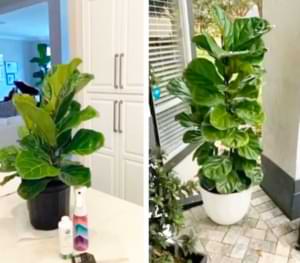
Here is a before-and-after image of this plant growth, so you can see how fast fiddle leaf figs grow. In general, they can grow 18 inches in height per year if you give them the proper nutrients. If you’re starting with a small plant and you want it to get big, I recommend fertilizing and taking some pictures every couple of weeks to see how fast it grows—it really is amazing. Check out our Fiddle Leaf Fig Food on Amazon.
The Most Common Fiddle Leaf Fig Care Problems
I get emails every day from people that are having problems with their fiddle leaf figs. Once in a while I see something I’ve never seen before, but generally 90% of the problems are the same big problems. So I’m going to go through these with the hope that I will answer any questions or issues that you are experiencing with your plant.
Root Rot
Root rot is, by and large, the number-one issue that we see, so knowing how to treat and prevent root rot in a fiddle leaf fig is important. If your plant is afflicted with root rot, you will see brown spots or black areas and dropping leaves. It can start at the stem and spread, or it can start as spots on your plant, almost like the spots on a dalmatian, and those spots will spread. Although there are a couple different kinds of root rot, the treatment is the same.
Root rot is very common in new plants, particularly when you bring your plant home from the nursery and you put it in a relatively dark environment; they can drop all of their leaves in just a couple of weeks. It’s very depressing if you spend a lot of money on a plant, you bring it home, and it loses all of its leaves. Just remember, it’s not your fault!
Beware if you purchase your fiddle leaf fig from a big-box store. Typically, while they’re grown in these nurseries, they’re treated with really strong treatments (chemicals and fungicides) that basically prevent any infection of root rot. So it’s not really fair that as soon as you get your plant home, it’s no longer receiving that kind of medication anymore, which means it’s extremely susceptible to root rot—especially considering that at the same time you’re bringing it home and cutting its light in half (or maybe more). So all of a sudden your plant doesn’t have antibiotics anymore and it doesn’t have enough light, and it can just spiral downhill.
If this happens, don’t feel badly about it, as in some cases your plant is set up for failure. In order to prevent this, when you bring your new plant home, keep it in the sunniest location in your house and be very careful not to overwater it. You may even want to give it our Root Rot Treatment as a preventative measure to keep it from going downhill during this really critical transitional period.
The different types of root rot we see in ficus lyrata, or fiddle leaf figs:
- Bacterial
- Fungal
- Physical
- Difficult to determine
You can have a physical root rot of just the occlusion of the roots from sitting in water, and your plant will die from that even if your water is perfectly pure and there’s no bacteria or fungus in it. It can sometimes be a little difficult to determine the type of root rot plaguing your plant. We have some blog posts that go through how to identify what type of root rot, but it almost doesn’t matter because the treatments are exactly the same.
Root Rot Treatment
Typical root rot treatments include chemicals, fungicides, and toxic and hazardous materials. I have two babies and a third on the way—I don’t know about you, but I don’t want toxic things in my home. And I really don’t want them on my plant. So we developed our Root Rot Treatment to be completely natural, with no harsh chemicals, with plant-derived ingredients to treat fungus and bacteria. And it works with your plant to boost your plant’s natural immunity. So if you’re looking for a natural solution that really works with the health of your plant, check out our Root Rot Treatment on Amazon. It’s a good supplement that helps to give your plant that defense that it needs against root rot. I use it on all my plants every time I water just to keep them healthy.

Red Spots
The next thing we see often is red spots on fiddle leaf figs. This one is actually kind of cool, so I’m always happy when people ask me about this. These tiny red spots appear on new growth for your fiddle leaf fig.

You can see it looks pretty terrible. So, your fiddle has this great new growth spurt and you’re so excited, but then it’s mottled by all these red spots. It looks like they’re being damaged, but it’s actually fine, there’s nothing to worry about. It’s completely normal.
These red spots are actually a bursting of your plant’s cells basically due to too much water while they’re growing. It’s better to give your plant too much water while it grows than too little. If you don’t give it enough water during the growth spurt, it can lead to the stunted growth we mentioned earlier. So with these red spots, you just don’t need to do anything. They’ll fade as your leaf grows, and that’s a good sign. New growth means your plants are happy and healthy. So just don’t worry about these and keep taking pictures each day and you’ll see them fade.
Insect Problems
Insects are common on fiddle leaf figs in certain areas of the country, especially in the South, so be aware. The telltale sign for insects is holes in the leaves or you can see the actual insect activity. You’ll see flies, bugs, spider mites, or webs of spider mites, so keep an eye on and physically inspect your plant to ensure you don’t have insect activity. We created a product for insect treatment on fiddle leaf figs, our Houseplant Leaf Armor. It not only protects your plant from insects, bacteria, and fungus, but also cleans and adds shine to its leaves!

Sunburn
Sunburn is also a frequent problem for fiddle leaf figs, especially during summer when people put their plants outside. If your plant gets too much direct sunlight, it can get a sunburn, which manifests as light brown spots that sometimes look bleached. These spots will appear predominantly on the top leaves and can even show some red and yellow coloring, depending on how recent the burn is. If you live in a nice warm climate, you can easily put your fiddle leaf fig outside, but put it in the shade because they do get sunburned if you put them in full sun. There are ways of acclimating them to full sun over time, so that is an option, however, if you take it from indoors and put it directly in full sun, they will get sunburned. And unfortunately, these leaves will not recover and you will need to remove them.
Trauma
If you see holes in your plant’s leaves, first check for insects. If there’s no sign of insect infestation, the holes could be caused by trauma. Moving your plant from the nursery to your home often results in your plant getting bruised. And then over a couple days or a week, those bruises kind of harden up into scabs and eventually into holes. Or say it’s a really windy day and your plant gets a lot of wind sitting on your balcony; it can get physical trauma that might appear a week later as a physical hole in the leaf. Someone might think, “Oh, no, I have insects.” Well, it may be that your plant was physically traumatized earlier, and this is just kind of the scar that is left. It’s not a big deal if you see holes like these that aren’t spreading, and there’s no sign of root rot or insect infestation. Fiddles have such big leaves that sometimes they get physical trauma, and you can remove the leaf if it bothers you.
The Most Important Trick To Help Your Plant Thrive
The best trick to help your plant thrive is to bond with it! We talked about this a little bit earlier, but I really encourage you to name your plant. This is a game-changer. Once you name your plant, you will suddenly experience a better relationship with it, and it will be healthier as a result. I still have fiddle leaf figs that I haven’t named. I don’t know why, but they’re never the healthiest plants or do as well as my fiddles I’ve named: Goose, Clive, Fig Newton, and Figgy Smalls. There are so many cute fiddle leaf fig names—check out our Facebook group for a list of the top names!
Naming your plant really does help you remember to water it, bond with it, and create that relationship that’s going to be rewarding for both of you.
Propagation Strategies
What’s better than one fiddle leaf fig? Two fiddle leaf figs! Propagation allows you to clone your favorite plants, grow your plant collection, and enjoy new plants to gift or keep. Our Propagation Promoter is specifically designed to provide essential nutrients that encourage new growth for a wide variety of houseplant cuttings.
How To Propagate a Fiddle Leaf Fig
Step 1: Take a cutting of your favorite plant.
Cut at least 1 inch below the leaf or node. A node is where a leaf or branch attaches to the stem or trunk. It may also look like a small knob on the stem. Use sharp, clean pruning shears or a knife to take a clean cutting and prevent the spread of bacteria.
Step 2: Place the cutting in a glass or jar of clean water. Make sure the stem is in the water, but the leaf is not submerged. Leave the cutting in a bright place with plenty of indirect sunlight and no direct sun.
Step 3: Add 1 teaspoon of Houseplant Propagation Promoter to the water.
Step 4: Check the stem each day to make sure it’s still submerged. Add a little water as needed and replace the water and Houseplant Propagation Promoter if the water looks cloudy or dirty.
Step 5: Wait for roots to grow! This may take between 3-8 weeks depending on the type of plant.
To plant your new cutting: When roots on your new cutting are 1 inch long, plant in damp soil.
When you water your new plant, add 1 teaspoon of Houseplant Propagation Promoter for every 2 cups of water. And then what? Enjoy your new plant!
Which Parts Of The Plant Should You Propagate?
You may choose to propagate for many reasons. Maybe you simply want to grow your houseplant collection (we don’t blame you!). Maybe you’d like to save part of a plant that’s not doing so well. Or maybe you’re pruning your plant and don’t want the cuttings to go to waste. These decisions greatly affect where you should take your cuttings!
Try these tips:
If you’re already pruning: Take the cuttings from the pruned pieces, or propagate the entire branch, stem, or leaf you removed.
Are you saving a dying plant?: Take a cutting from the healthiest part that you can.
Are you propagating from a healthy plant?: The newer leaves and stems may work best. These new leaves are smaller and require fewer nutrients to thrive, and contain a high amount of growth hormone since they’re still growing!
Propagation Success Tips:
Tip #1: Keep your new cutting warm if you can. They do best with lots of indirect light and in warm conditions.
Tip #2: Make sure your cutting has a long enough stem to root in water without immersing any part of the leaf.
Tip #3: To increase your chances of success, try taking more than one cutting!
Tip #4: Ensure your jars or glasses are clean and sterile before rooting your cuttings in water.
Our Exclusive Houseplant Propagation Promoter
To propagate more quickly and with more success, we recommend using our newly designed Houseplant Propagation Promoter. The exclusive formula supports strong growth and photosynthesis, and protects new cuttings against bacteria and toxins that can cause new cuttings to fail. With this easy-to-use product, you will be able to clone your best plants more quickly, even tough-to-propagate species like fiddles. It also comes with a free Complete Propagation Guide, which includes photos and step-by-step instructions. Click here to buy now.

How to Learn More About Fiddle Leaf Fig Care
First of all, make sure you’re subscribed to our newsletter. You’ll also want to join our community on Facebook: Fiddle Leaf Fig Plant Resource Group.
Read The Fiddle Leaf Fig Expert, your complete guide to growing healthy fiddle leaf fig plants. Fiddle leaf fig care topics include: tips and tricks, pruning, shaping, cleaning, propagation, and more! The book is available in full-color paperback or Kindle edition on Amazon now!
For those fiddle leaf fig lovers looking for information on advanced fiddle leaf fig care, check out our free Fiddle Leaf Fig Care 101 Webinar and our free Fiddle Leaf Fig Care Course. Course topics include:
- Fighting root rot naturally
- Aeration and repotting
- Pruning your plant into a tree
- Propagation to clone your plant
- Notching to encourage new branches
- Troubleshooting insect problems
- Treating brown spots
- More!
Shop The Fiddle Leaf Fig Store
For all your fiddle leaf fig care essentials in one place, check out our store here! Looking to shop for plants online? Our trusted partners at Houseplantshop.com grow high-quality plants here in California and ship directly to you. Shop online now!
